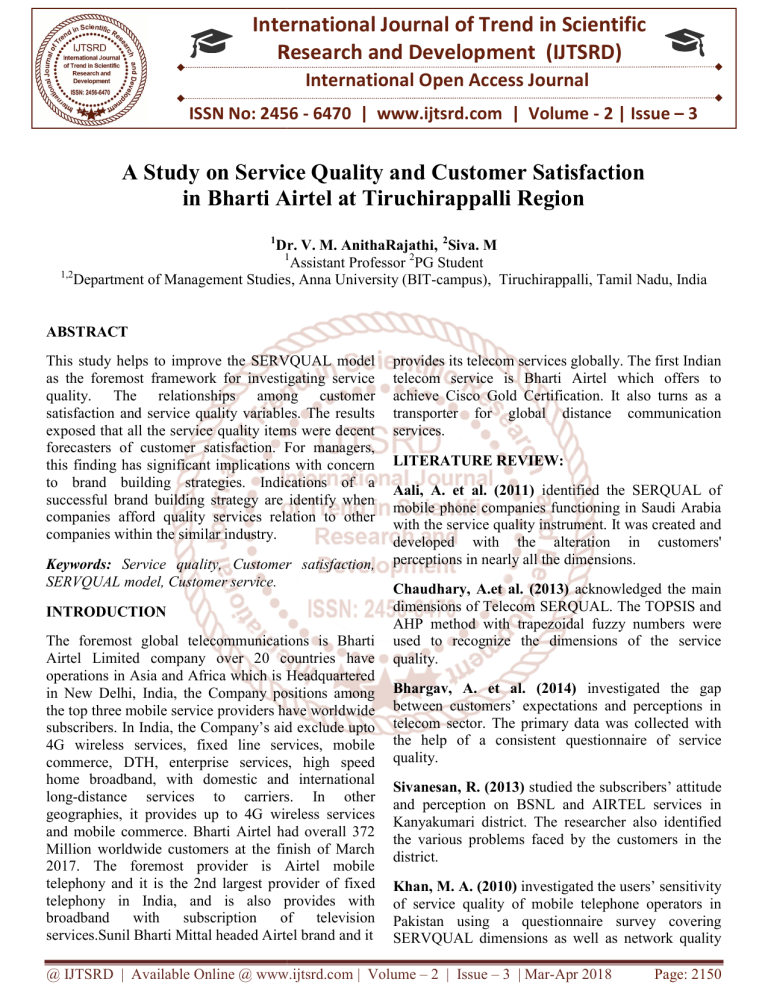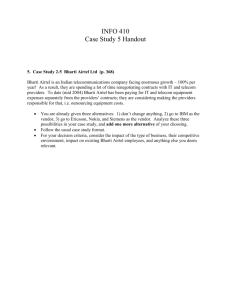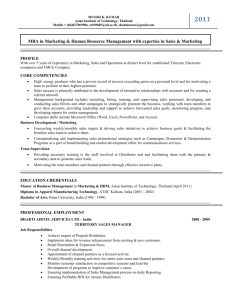
International Journal of Trend in Scientific
Research and Development (IJTSRD)
International Open Access Journal
ISSN No: 2456 - 6470 | www.ijtsrd.com | Volume - 2 | Issue – 3
A Study on Service Quality and Customer Satisfaction
in Bharti Airtel at Tiruchirappalli Region
1
Dr. V. M. AnithaRajathi, 2Siva. M
1
Assistant Professor 2PG Student
1,2
Department of Management Studies
Studies, Anna University (BIT-campus), Tiruchirappalli, Tamil Nadu, India
ABSTRACT
This study helps to improve the SERVQUAL model
as the foremost framework for investigating service
quality. The relationships among customer
satisfaction and service quality variables. The results
exposed that all the service quality items were decent
forecasters of customer satisfaction. For managers,
this finding has significant implications with concern
to brand
and building strategies. Indications of a
successful brand building strategy are identify when
companies afford quality services relation to other
companies within the similar industry.
Keywords: Service quality, Customer satisfaction,
SERVQUAL model, Customer service.
INTRODUCTION
The foremost global telecommunications is Bharti
Airtel Limited company over 20 countries have
operations in Asia and Africa which is Headquartered
in New Delhi, India, the Company positions among
the top three mobile service providers have worldwide
subscribers. In India, the Company’s aid exclude upto
4G wireless services, fixed line services, mobile
commerce, DTH, enterprise services, high speed
home broadband, with domestic and international
long-distance services to carriers.
rs. In other
geographies, it provides up to 4G wireless services
and mobile commerce. Bharti Airtel had overall 372
Million worldwide customers at the finish of March
2017. The foremost provider is Airtel mobile
telephony and it is the 2nd largest provider of fixed
telephony in India, and is also provides with
broadband
with
subscription
of
television
services.Sunil Bharti Mittal headed Airtel brand and it
provides its telecom services globally. The first Indian
telecom service is Bharti Airtel which offers to
achieve Cisco Gold Certification. It also turns as a
transporter for global distance communication
services.
LITERATURE REVIEW:
Aali, A. et al. (2011) identified the SERQUAL of
mobile phone companies functioning in Saudi Arabia
with the service
rvice quality instrument. It was created and
developed with the alteration in customers'
perceptions in nearly all the dimensions.
Chaudhary, A.et al. (2013) acknowledged the main
dimensions of Telecom SERQUAL. The TOPSIS and
AHP method with trapezoidal fuzzy
fu
numbers were
used to recognize the dimensions of the service
quality.
Bhargav, A. et al. (2014) investigated the gap
between customers’ expectations and perceptions in
telecom sector. The primary data was collected with
the help of a consistent questionnaire
questio
of service
quality.
Sivanesan, R. (2013) studied the subscribers’ attitude
and perception on BSNL and AIRTEL services in
Kanyakumari district. The researcher also identified
the various problems faced by the customers in the
district.
Khan, M. A. (2010) investigated the users’ sensitivity
of service quality of mobile telephone operators in
Pakistan using a questionnaire survey covering
SERVQUAL dimensions as well as network quality
@ IJTSRD | Available Online @ www.ijtsrd.com | Volume – 2 | Issue – 3 | Mar-Apr
Apr 2018
Page: 2150
International Journal of Trend in Scientific Research and Development (IJTSRD) ISSN: 2456-6470
and convenience as an additional dimensions.
Convenience and network quality was found to be
relatively most important dimensions.
To identify customers preference towards the
Bharti Airtel mobile service provider in
Tiruchirappalli region.
Dabhade, N. et al. (2013) studied the impression of
quality of service on customer satisfaction of mobile
users by considering the case of Airtel and identified
the factors that affect quality of services. This paper
examined improvements in performance and it
measures which were implemented up by the Airtel to
improve customer satisfaction level.
To measure the Service Quality of Bharti Airtel
mobile Service provider in Tiruchirappalli region.
OBJECTIVES
To study the demographic profile of the customers
of Bharti Airtel mobile service provider in
Tiruchirappalli region.
Tangibility: It refers to the presence of physical
facilities, equipment, personnel,
documents etc.
Reliability: It is the Ability to deliver the promised
service perfectly and within a predefined time period.
Responsiveness: Responding to customer as and
when required. In other word it requires
Good customer care service with willingness
Assurance: Knowledge and courtesy of employees
and their ability to inspire trust and confidence. This
builds a tight and positive bonding between the
customer and the service provider
Empathy: Empathy means understanding. The
service provider must have a clear-cut understanding
that what customer requires. Service providers must
be Caring and should provide individual attention to
customers.
MEASUREMENT OF VARIABLES
Parasuraman, Zeithmal & Berry,1988; Ndubisi, Chan,
& Chukwunonso, 2004Service quality was restrained
by expenditures the variables in SERVQUAL model.
In using the SERVQUAL implement, 21 statements
measured the service quality across these elements,
using a seven point Likert scale. The influences in the
model were measured as follows:
SERVICE QUALITY GAP
In earlier service research, conference and more than
chances of clients and consumers is a perception that
has increased most attraction. This concept is all
inclusive and cuts across service domains, but
expectations change and experiences with alternate
service providers could shape the customers’
expectations. The important investigation gap here is
attaining customers’ expectation towards a particular
service.
A gap is the difference, imbalance or disparity which
is determined to exist between customers’ perception
of firm performance and their prior expectation.
Service quality (SQ) perceived by customers is then
as consequence of a contrast of customers’
expectation (E) of facilities that the association should
offer versus their perception of the performance (P)
delivered by the service organization.
Network Quality: It refers to the strength of the
network and call quality.
@ IJTSRD | Available Online @ www.ijtsrd.com | Volume – 2 | Issue – 3 | Mar-Apr 2018
Page: 2151
International Journal of Trend in Scientific Research and Development (IJTSRD) ISSN: 2456-6470
Service Quality (SQ) = Customer’s Expectations (E) – Customer’s Perception (P)
Expectations and perceptions of customers is
management of service quality largely focuses on
managing the gaps. The goal of the firm is to reduce
the gap between (E) and (P). Rowleypointed out that
previous scholars such as Lehtinen and Lehtinen and
Gronroos also applied gapmoralities similar to that
upcoming by Parasuraman et al.
CUSTOMER SATISFACTION
Customer Satisfaction has been a central concept in
marketing fiction and is an important goal of all
business activities. Today, companies face their
toughest competition, because they move from a
product and sales philosophy to a marketing
philosophy, which gives a company a better chance of
outperforming competition (Kotler, 2000). Overall
customer satisfaction translates to more profits for
companies and market share increase. The importance
of customers has been highlighted by many
researchers and academicians. The primary concern of
promotion is to connect with customers by building a
strong customer relationship in order to meet their
expectations. Therefore, managers who see customers
as the only way of profit, they consider. Customer
satisfaction has a positive effect on an organization’s
profitability. The more customers are satisfied with
produces or services accessible, the more are chances
for any successful business as customer satisfaction
leads to repeat purchase, brand loyalty, and positive
word of mouth marketing. Customer satisfaction leads
to repeat purchases, loyalty and to customer retention
(Zairi, 2000). Today most successful companies have
taken the strategy of raising expectations and
delivering performance to match. Such companies
track their customers‟ expectations, perceived
company presentation, and customer satisfaction.
Highly satisfied customers produce several benefits
for the company. Satisfied customers remain
connected for a longer period and talk favorably to
others about the company and its products and
services.
CUSTOMER SATISFACTION INFLUENCES
OF PREPAID CUSTOMERS OF AIRTEL
Bharti Airtelmobile telecommunication industry,
around are through and indirect factors that effect
customer satisfaction. Here Research attention on the
Maximum significant factors that inspiration
consumer satisfaction for prepaid consumers of Airtel
which relates fundamentally with after sales services.
COST
The cost of the prepaid connection is one of major
factor for the customers. Most of the people in India
are low income level. Therefore, to attain more
customers Airtel should not charge high price for the
new connection so that it can be affordable to the low
income people. Moreover, tariff of the prepaid
packages must be judicious to keep satisfied its
customers.
AVAILABILITY
Availability of the product at the right time leads the
customers to a better experience. Customers always
want the product to be availed near at home. They do
not wish to go far to have product and other related
services. Though, the prepaid customers require topup their credit more frequently. So, to ensure frequent
purchase and to build up long term relationship with
the customers, the top-up stores should be
conveniently located to the prepaid users.
CUSTOMER PERCEPTION
Customer perception is valuation approximately
something watched and restrained and it contrasts
from customers to customers, as individually
customer takes changed opinions towards confident
services and products that performance of significant
role in determining customer satisfaction. Customer
satisfaction is determined by the customers’
perceptions and opportunities of the excellence of the
products and services. In several cases, customer
perception is independent, but it offers some useful
understandings for organizations to improve their
marketing strategies. Providing high level of quality
service has become the selling point to attract
customer’s helpfulness and is the most significant
driver that principals to satisfaction. Hence, customer
perception and customer satisfaction are very
thoroughly linked composed, because if the apparent
service is near to customer’s opportunities it
principals to satisfaction. Satisfied customers deliver
recommendations; maintain faithfulness towards the
@ IJTSRD | Available Online @ www.ijtsrd.com | Volume – 2 | Issue – 3 | Mar-Apr 2018
Page: 2152
International Journal of Trend in Scientific Research and Development (IJTSRD) ISSN: 2456-6470
company and customers in turn are additional likely to
pay price dividends (Reichheld, 1996).
CONCLUSION
Airtel is a telecom service providing company where
customer satisfaction is together goal and marketing
tool. Today’s customers in the telecom industry,
where lots of offers are available, are harder to satisfy.
They remain smoother, more challenging, more price
conscious, less forgiving and they are innovative by
many more companies with equivalent or better
offers. The experiment is not only to produce satisfied
customers also to produce loyal and delighted
customer. This is competitive and customer driven
market. It is high time for Airtel to satisfy and retain
its existing customers. As the mobile connection
price, call duty, even the price of the handset have
been reduced due to technological advancement
people of all income level are started using cell phone.
Nowadays, most of the students and the low income
people are deeply relying on Airtel because of the
cheap cost. Hence, it has become inevitable for Airtel
to expand the network coverage soon for a
maintainable future.
REFERENCES
1) V.A. Parasuraman, A. Zeithaml, L. Berry. A
Conceptual Model of Service Quality and Its
Implications for theFuture Research.
2) V.A. Zeithaml, A. Parasuraman, L.L. Berry.
Delivering quality service: Balancing customer
perceptions andexpectations. 1990. New York:
The Free Press.
3) P. Kotler, G. Amstrong. Principles of Marketing,
11th Ed., New Jersey, Pearson Prentice Hall 2006.
4) A. Q. Othman, L. Owen. The Multidimensionality
of Carter Model to Measure Customer Service
quality (SQ) inIslamic Banking Industry: A Study
in Kuwait Finance House. International Journal
of Islamic Financial Services.2000. 3(4).
5) A. Q. Othman, L. Owen. Adopting and Measuring
Customer Service Quality in Islamic Banks: A
Case Study inKuwait Finance House”,
International Journal of
Services. 2001. 1(3): 6-12.
Islamic
Financial
6) H. Sudin, W. Nursofiza. S. Shafie. Adopting and
Measuring Customer Service Quality (SQ) in
Islamic Banks: ACase Study in Bank Islam
Malaysia Berhad. Proceedings of National
Seminar
in
Islamic
Banking
and
Finance,Putrajaya, Kuala Lumpur, 2004.March,
91-102.
7) M.T. Izah, W. Z. W. Ismail. Service Quality in the
Financial Services Industry in Malaysia: The Case
of IslamicBanks and Insurance. International
Review of Business Research Papers. 2005. 1(2):
10-21.
8) P. Hernon, D. A. Nitecki. Service Quality: A
Concept Not Fully Explored Library Trends.2001.
49(4): 687-708
9) V.A. Zeithaml, and M.J. Bitner. Service
Marketing: Integrating Customer Focus across
the Firm. NY: McGraw-Hill. 2003
10) Rowley, J. (1997). Beyond Service Quality
Dimensions in Higher Education and Towards a
Service Contract.Quality Assurance in Education,
5(1): 7-14.
11) J.R. Lehtinen, and U. Lehtinen Service quality: a
study of quality dimensions, Unpublished working
paper, ServiceManagement Institute, Helsinki
1982
12) Gronroos, C. 1988. The service quality: The six
criteria of good perceived service quality, Review
of Business, 9:10-13
13) R. L. Oliver. A cognitive model of the antecedents
and consequences of satisfaction decisions.
Journal ofMarketing Research. 1980 17, 460-469.
14) B. Leisen, and C. Vance. Cross-national
Assessment
of
Service
Quality
in
Telecommunication. Journal ofMarketing. 2001.
11(5):.307-317.
15) E.W. Anderson, C. Fornell, D.R. Lehmann,
Customer satisfaction, market share, and
profitability: findings fromSweden, Journal of
Marketing, 1994 58, July.53-66.
@ IJTSRD | Available Online @ www.ijtsrd.com | Volume – 2 | Issue – 3 | Mar-Apr 2018
Page: 2153



